Key takeaways:
- City murals reflect community identity and foster pride, acting as canvases for untold stories and local narratives.
- Successful mural projects involve community engagement, from brainstorming sessions to gathering input, enhancing sense of ownership.
- Collaboration with local artists strengthens the mural’s connection to the community, making art more meaningful and inspiring dialogue.
- Funding for mural initiatives can arise from local businesses, grants, and crowdfunding, highlighting community investment in local art.
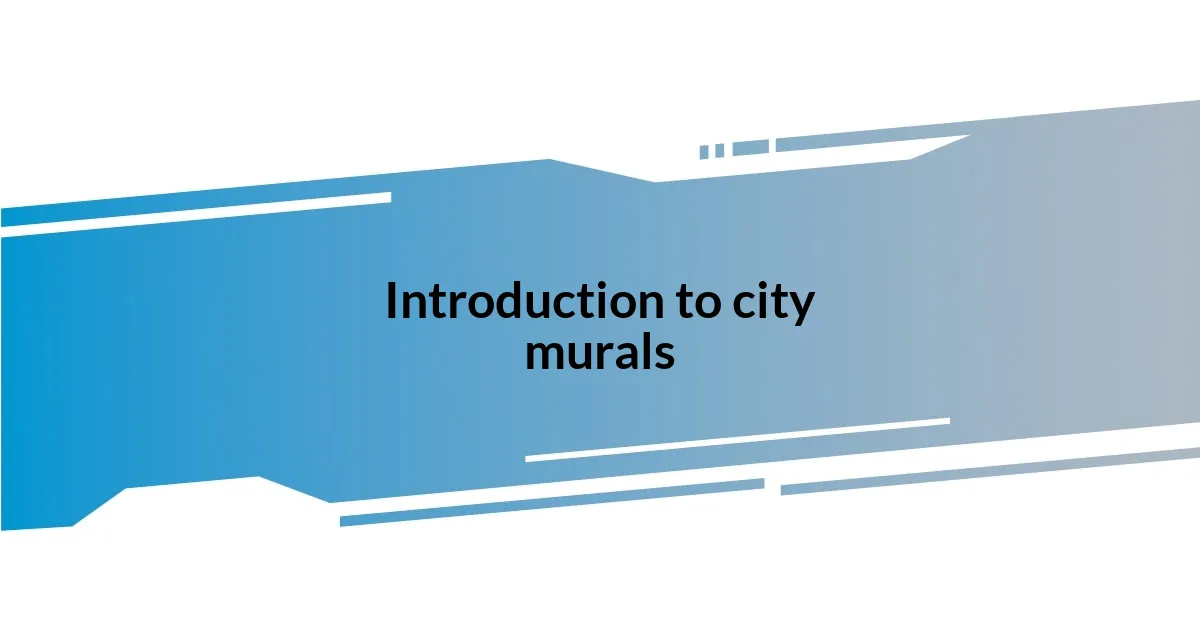
Introduction to city murals
City murals are more than just splashes of paint on walls; they pulse with life and character, reflecting the unique identity of a community. I remember the first time I encountered a mural in my city—it transformed a dull street corner into a vibrant gathering spot. Have you ever felt a sudden spark of inspiration just by the sight of colors coming alive in your surroundings?
As I walked through neighborhoods adorned with breathtaking artworks, I began to see murals as canvases of expression, telling stories that often went untold. Each piece seemed to convey the hopes and struggles of the people who lived nearby, almost like inviting me to listen in on a conversation. Isn’t it fascinating how art can bridge gaps between individuals, sparking dialogues where words sometimes fall short?
Murals can also serve as catalysts for change, fostering a sense of belonging and pride among locals. I’ve witnessed firsthand how a once-neglected space blossomed into an engaging visual narrative, drawing in visitors and revitalizing community spirit. Isn’t it incredible how a simple act of creativity can uplift not just the aesthetics of a space but the emotions of those who inhabit it?
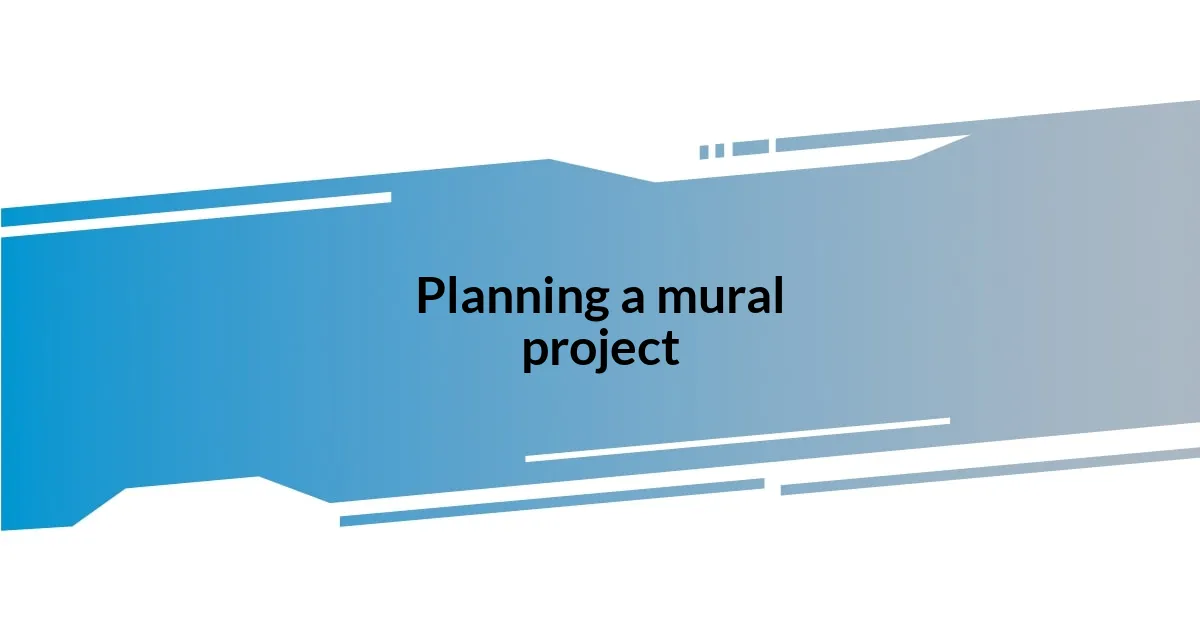
Planning a mural project
Planning a mural project is an exhilarating journey, one that begins with a vision and community involvement. I remember my excitement when I gathered a group of friends and neighbors to brainstorm ideas for our first mural. We spread out a giant piece of paper and let our imaginations run wild. That session not only ignited creativity but also strengthened our connections. Involving the community ensures that the mural resonates with local culture and stories, which can lead to a sense of ownership and pride among the residents.
Here are some key steps to consider when planning your mural project:
- Identify a location: Choose a visible spot that could benefit from artistic enhancement.
- Engage the community: Host meetings or surveys to gather input and ideas.
- Select an artist: Look for local artists whose style aligns with the project vision. Consider collaborations for a more inclusive approach.
- Funding and permits: Research potential funding sources and apply for necessary permits well in advance.
- Design the mural: Once the artist is onboard, work together to finalize the design, blending community input and artistic vision.
- Plan for maintenance: Ensure a plan is in place to care for and preserve the mural over time.
Taking these steps can transform a simple idea into a powerful visual statement that captures the heart of your community.
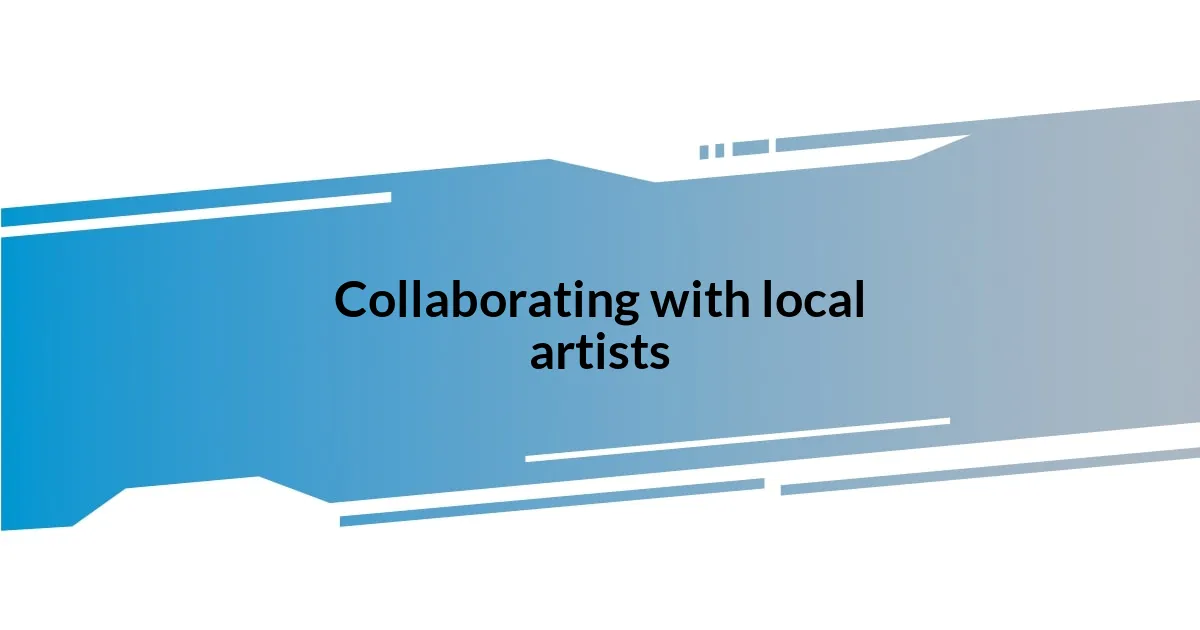
Collaborating with local artists
Collaborating with local artists is a game-changer in the mural-making process. When I reached out to artists in my city, their passion and connection to the community shone through. I remember the initial meeting with a talented local artist, who shared stories about how they grew up in the area. Their insight into the neighborhood’s history shaped our project’s overall vision, making the mural a true reflection of our shared roots.
One of the most rewarding aspects of working with local artists is witnessing the magic that happens when creativity collides. I watched as the artist and community members bounced ideas off each other, transforming ordinary concepts into something extraordinary. It reminded me of how collaboration can cultivate not just artistic growth but also a sense of belonging and unity among diverse voices.
Through these partnerships, I learned that every brushstroke holds a deeper meaning when the artist is invested in the community. For instance, one artist incorporated elements inspired by interviews with local residents. The result was a mural that felt alive; it was a tapestry of perspectives woven together. This approach not only beautified our city but also sparked conversations and connections that would last long after the paint had dried.
| Aspect | Local Artist Collaboration |
|---|---|
| Unique Perspective | Artists often have deep ties to the community, infusing personal stories into their art. |
| Creativity Enhancement | Collaborative brainstorming sessions can lead to innovative ideas that resonate with residents. |
| Community Ownership | When locals participate, they feel a sense of pride and responsibility for the artwork. |
| Cultural Reflection | Murals created by local artists can highlight and celebrate the area’s diverse heritage. |
| Long-term Impact | Art that features community input tends to remain relevant and continue to inspire dialogue. |
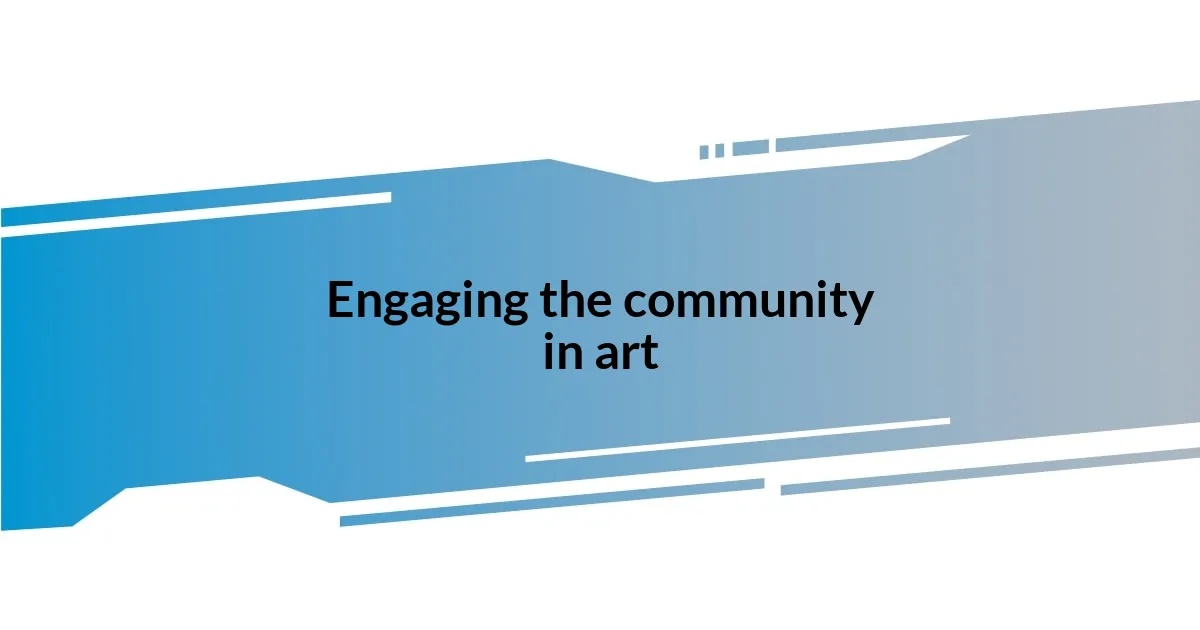
Engaging the community in art
It was incredible to see how gathering community members for brainstorming sessions fueled excitement and ownership. One evening, as we sat under the stars, ideas flowed like paint on canvas—everyone had something to contribute, and every voice mattered. It was a reminder of how art can transcend boundaries and spark joy, making participants feel valued and connected to something larger than themselves.
As we engaged locals through surveys and discussions, I was struck by the hidden treasures of stories shared. One older resident recounted a beloved childhood memory tied to a worn-out wall, which inspired a vibrant scene in our mural. Can you imagine the smiles and nostalgia when that memory was brought to life? It felt like breathing new life into the collective past while also creating a narrative for future generations to cherish.
Involving the community was more than just gathering ideas; it became a catalyst for empathy and understanding. I remember witnessing a teenager collaborate with a retiree—two generations bridging gaps through creativity. I often wondered, how can something as simple as a mural unite such diverse experiences? The answer became clear: when people come together to share their perspectives, we weave a tapestry of love and respect that strengthens our community fabric, making every stroke of paint resonate deeply.
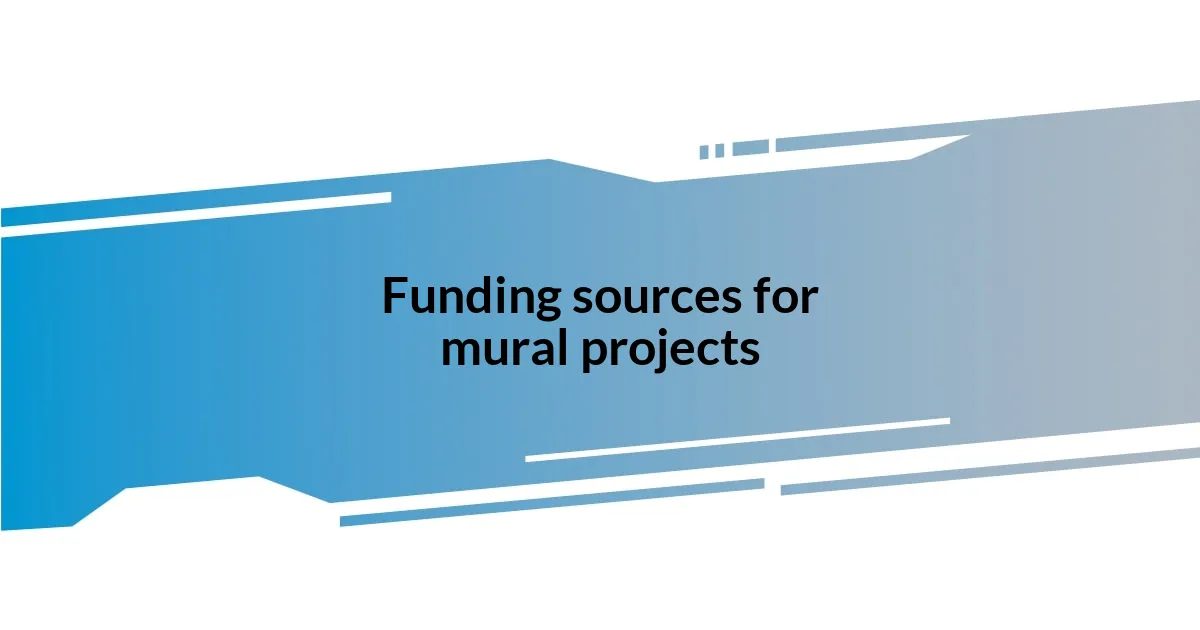
Funding sources for mural projects
Funding for mural projects can come from a variety of sources, each with its own unique benefits and challenges. I’ve found that local businesses are often a great place to start. When I approached a few shop owners in my neighborhood, they were eager to contribute not just financially but also by offering wall space, which made the project feel more like a community effort. Sometimes, you just need to ask—and you’d be surprised how many people want to support local art.
Grants are another key funding source worth exploring. I remember applying for a community arts grant to fund one of our larger mural projects. Crafting the proposal was daunting at first, but it forced me to articulate our vision clearly. The application process itself sparked discussions among our team about the impact we hoped to achieve. When we finally received the funding, it felt like a shared victory for everyone involved, boosting our morale and commitment to the project.
Additionally, crowdfunding can be a powerful tool that empowers the community to invest in its own transformation. I decided to launch a crowdfunding campaign for a mural that aimed to celebrate our city’s history. Watching the campaign take off as friends and strangers shared it on social media was exhilarating. It not only raised the funds we needed but also created a buzz around the project. The small donations from community members reminded me that when people feel a connection, they’re often willing to support it financially. Isn’t it amazing how art can forge bonds and bring resources to the forefront?
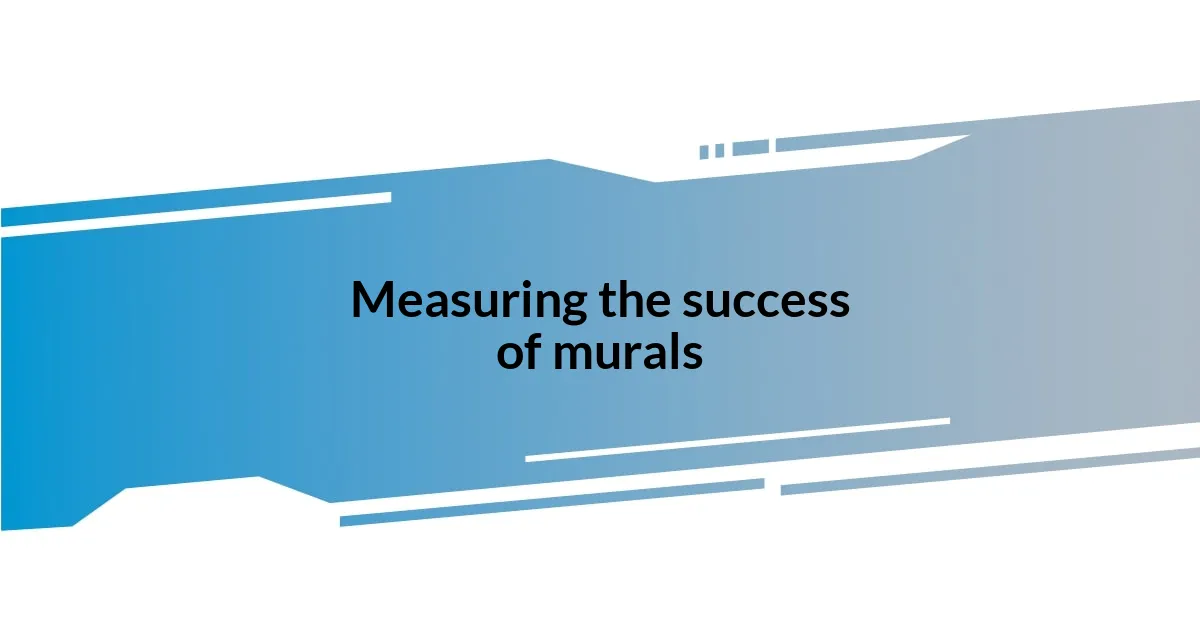
Measuring the success of murals
Measuring the success of murals isn’t solely about aesthetic appeal; it’s also about how they foster community connections and dialogue. I remember an instance when a mural sparked a conversation around environmental issues in our city. People began discussing sustainability, and it fascinated me to see how art transcended its visual boundaries and moved into meaningful discussions, suggesting that successful murals should encourage ongoing engagement, not just passive observation.
Another key metric I’ve observed is foot traffic. After installing a mural in a previously overlooked alleyway, I watched it transform into a vibrant gathering spot. The foot traffic increased significantly, with people stopping to take photos, share stories, and enjoy local businesses nearby. It’s astounding how a splash of color can reinvigorate a space, but I always ask myself—how much more potential does a well-placed mural have to continually draw people in and inspire them?
Lastly, I often turn to feedback collected from community interfaces—surveys and casual conversations at local events often yield the richest insights. At one of our mural unveilings, a child gasped in delight, pointing out elements that reminded them of their favorite bedtime stories. That joy felt contagious, reminding me that success isn’t just measured through numbers; it’s also about the emotional and nostalgic connections we create. How fulfilling it is to know that our work might resonate with someone on a personal level!